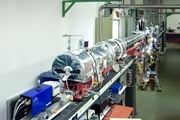High pressure shock tube

Aim
Shock tubes are frequently used to study the kinetics of high temperature gas-phase reactions. A shock wave that is initiated by a gas expansion heats the reactive gas mixture within less than a microsecond to temperatures up to several thousand Kelvin. The subsequent reaction is observed via optical techniques. The High-Pressure Shock Tube at IVG allows to study ignition delay times of undiluted fuel/air mixtures that are relevant for the modeling of the behavior of practical fuels for internal combustion engines. Of specific interest is the dependence of ignition delay times on the chemical composition of the fuel. The measured data support the theoretical description of the ignition and combustion chemistry and, thus, the use of new fuels (e.g. bio-derived) and the tailoring of fuel mixtures for specific applications. The study of the ignition behavior of mixtures of gaseous fuels and air are additionally of interest for the development of clean-burning gas turbines and for studying safety issues.
Approach
The shock tube has a total length of 12.5 m an inner diameter of 90 mm. It is divided by an aluminum diaphragm (up to 7 mm thickness) into a driver section of 6.1 m and a driven section of 6.4 m in length. The reactive gas mixtures are prepared in a stainless-steel mixing vessel. The driver section is filled up to 100 bar with He / Ar mixtures until the diaphragm breaks. Adjusting the driver gas mixture allows to realize test times of up to 15 ms. The maximum post-combustion pressure is 500 bar. The driven section and the mixing vessel can be heated electrically up to 250°C to allow the study of low vapor-pressure fuels. Shock wave speeds and ignition are observed via pressure transducers. The flame luminescence is detected with photomultipliers and with CCD cameras through an optional window in the end flange. Gas samples can be taken from the gas and analyzed with a GC/MS (gas chromatograph / mass spectrometer) system in order to investigate potential variations in gas composition prior to ignition. Comparable facilities are available in less than 10 labs worldwide.
References
Herzler, J.; Fikri, M.; Hitzbleck, K.; Starke, R.; Schulz, C.; Roth P.; Kalghatgi, G. T. Combust. Flame 2007, 149, 25-31.
Cancino, L. R.; Fikri, M.; Oliveira, A. M. M.; Schulz, C. Proc. Combust. Inst. 2009, 32, 501-508.
Contact
Dr. M. Fikri, Mustapha Fikri, Tel: +49 (0)203 - 379 3037, IVG.
